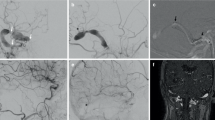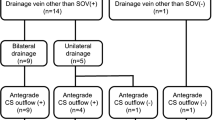Abstract
Introduction
Symptomatic intracranial hypertension (IH) due to venous outflow obstruction secondary to dural venous sinus (DVS) tumoral invasion affects up to 3% of intracranial meningioma patients. The literature regarding endovascular therapies of such patients is limited to a few case reports and a recent single-centre case series.
Purpose
We describe our single-centre experience of endovascular therapy in patients with clinically symptomatic IH secondary to DVS meningioma invasion.
Methods
We performed a retrospective review of clinical and radiological data of all patients with refractory IH and meningiomas invading the DVS who were referred for possible DVS venoplasty and stenting. Seven endovascular procedures in six female patients were done. Presumed secondarily induced lateral transverse sinus stenosis was also stented in four patients as part of the primary intervention.
Results
All patients experienced complete symptomatic resolution at 6-month follow-up. Five patients had no symptom recurrence over a mean follow-up period of 3.5 years. One patient with multiple meningiomas developed recurrent IH 2 years following stenting secondary to in-stent tumour re-invasion. This was re-stented with consequent 6 months post-retreatment symptomatic relief at the time of writing. No procedure-related complications occurred.
Conclusion
In the setting of DVS stenosis secondary to meningioma invasion, endovascular therapy is a safe and successful therapeutic option with promising mid-term results. The procedure should be considered in cases where complete surgical tumour resection is unlikely or carries a significant risk. If present, secondarily induced stenoses at the lateral ends of the transverse sinuses should also be considered for treatment.



Similar content being viewed by others
Data availability
The data that support the findings of this study are available from the corresponding author, upon reasonable request.
References
Durcan FJ, Corbett JJ, Wall M (1988) The incidence of pseudotumor cerebri. Population studies in Iowa and Louisiana. Arch Neurol 45(8):875–877
Radhakrishnan K, Ahlskog JE, Cross SA, Kurland LT, O’Fallon WM (1993) Idiopathic intracranial hypertension (pseudotumor cerebri). Descriptive epidemiology in Rochester, Minn, 1976 to 1990. Arch Neurol 50(1):78–80
Kesler A, Gadoth N (2001) Epidemiology of idiopathic intracranial hypertension in Israel. J Neuro-Ophthalmol Off J North Am NeuroOphthalmol Soc 21(1):12–14
McCluskey G, Mulholland DA, McCarron P, McCarron MO (2015) Idiopathic intracranial hypertension in the northwest of Northern Ireland: epidemiology and clinical management. Neuroepidemiology 45(1):34–39
Entezami P, Gooch MR, Dalfino J (2019) Endovascular stenting of the superior sagittal sinus to alleviate venous compression caused by a parasagittal meningioma. BMJ Case Rep 12(4):e227935
DiMeco F, Li KW, Casali C, Ciceri E, Giombini S, Filippini G et al (2008) Meningiomas invading the superior sagittal sinus: surgical experience in 108 cases. Neurosurgery 62(6 Suppl 3):1124–1135
Sindou MP, Alvernia JE (2006) Results of attempted radical tumor removal and venous repair in 100 consecutive meningiomas involving the major dural sinuses. J Neurosurg 105(4):514–525
Buster WP, Rodas RA, Fenstermaker RA, Kattner KA (2004) Major venous sinus resection in the surgical treatment of recurrent aggressive dural based tumors. Surg Neurol 62(6):522–529 discussion 529-530
Mathiesen T, Pettersson-Segerlind J, Kihlström L, Ulfarsson E (2014) Meningiomas engaging major venous sinuses. World Neurosurg 81(1):116–124
Han MS, Kim YJ, Moon KS, Lee KH, Yang JI, Kang WD et al (2016) Lessons from surgical outcome for intracranial meningioma involving major venous sinus. Medicine (Baltimore) 95(35):e4705
Raza SM, Gallia GL, Brem H, Weingart JD, Long DM, Olivi A (2010) Perioperative and long-term outcomes from the management of parasagittal meningiomas invading the superior sagittal sinus. Neurosurgery 67(4):885–893 discussion 893
Patsalides A, Oliveira C, Wilcox J, Brown K, Grover K, Gobin YP et al (2019) Venous sinus stenting lowers the intracranial pressure in patients with idiopathic intracranial hypertension. J Neurointerventional Surg 11(2):175–178
Koovor JM, Lopez GV, Riley K, Tejada J (2018) Transverse venous sinus stenting for idiopathic intracranial hypertension: safety and feasibility. Neuroradiol J 31(5):513–517
Higgins JNP, Owler BK, Cousins C, Pickard JD (2002) Venous sinus stenting for refractory benign intracranial hypertension. Lancet Lond Engl 359(9302):228–230
Takahashi Y, Suda Y, Fushimi S, Shibata K, Kondo R, Oda M et al (2020) Endovascular stenting following stereotactic radiosurgery for meningioma involving the superior sagittal sinus. J Neuroendovascular Ther 14(7):273–278
Chausson N, Bocquet J, Aveillan M, Olindo S, Signaté A, Merle H et al (2010) Intracranial hypertension caused by a meningioma compressing the transverse sinus. J Clin Neurosci Off J Neurosurg Soc Australas 17(12):1589–1592
Ganesan D, Higgins JNP, Harrower T, Burnet NG, Sarkies NJC, Manford M et al (2008) Stent placement for management of a small parasagittal meningioma. Technical note J Neurosurg 108(2):377–381
Zilani G, Pereira EAC, Baig F, Uberoi R, Kuker W, Kerr RSC (2009) Venoplasty and stenting of a jugular foramen meningioma. Br J Neurosurg 23(5):557–560
Higgins JNP, Burnet NG, Schwindack CF, Waters A (2008) Severe brain edema caused by a meningioma obstructing cerebral venous outflow and treated with venous sinus stenting: Case report. J Neurosurg 108(2):372–376
Szitkar B (2010) A meningioma exclusively located inside the superior sagittal sinus responsible for intracranial hypertension. AJNR Am J Neuroradiol 31(6):E57–E58
Higgins JNP, Kirollos SRW, Helmy A, Guilfoyle MR, Pickard JD, Axon PR, Joannides AJ, Jefferies S, Santarius T, Kirollos R (2023) Technical considerations and long-term results of endovascular venous stenting to control venous hypertension from meningiomas invading intracranial venous sinuses. J Neurosurg 1:1–13. https://doi.org/10.3171/2023.6.JNS23607
Burgett RA, Purvin VA, Kawasaki A (1997) Lumboperitoneal shunting for pseudotumor cerebri. Neurology 49(3):734–739
Eggenberger ER, Miller NR, Vitale S (1996) Lumboperitoneal shunt for the treatment of pseudotumor cerebri. Neurology 46(6):1524–1530
Johnston I, Besser M, Morgan MK (1988) Cerebrospinal fluid diversion in the treatment of benign intracranial hypertension. J Neurosurg 69(2):195–202
Sunderland GJ, Jenkinson MD, Conroy EJ, Gamble C, Mallucci CL (2021) Neurosurgical CSF diversion in idiopathic intracranial hypertension: a narrative review. Life Basel Switz 11(5):393
Wang VY, Barbaro NM, Lawton MT, Pitts L, Kunwar S, Parsa AT et al (2007) Complications of lumboperitoneal shunts. Neurosurgery 60(6):1045–1048 discussion 1049
Rosenberg ML, Corbett JJ, Smith C, Goodwin J, Sergott R, Savino P et al (1993) Cerebrospinal fluid diversion procedures in pseudotumor cerebri. Neurology 43(6):1071–1072
Suri A, Pandey P, Mehta VS (2002) Subarachnoid hemorrhage and intracereebral hematoma following lumboperitoneal shunt for pseudotumor cerebri: a rare complication. Neurol India 50(4):508–510
Banta JT, Farris BK (2000) Pseudotumor cerebri and optic nerve sheath decompression. Ophthalmology 107(10):1907–1912
Brazis PW (2008) Clinical review: the surgical treatment of idiopathic pseudotumour cerebri (idiopathic intracranial hypertension). Cephalalgia Int J Headache 28(12):1361–1373
Plotnik JL, Kosmorsky GS (1993) Operative complications of optic nerve sheath decompression. Ophthalmology 100(5):683–690
Mariniello G, Giamundo A, Donzelli R, Severino R, Russo C, Elefante A et al (2013) Intracranial hypertension due to meningioma of the unique transverse sinus. Neuroradiol J 26(2):209–212
Hunt MG, Lee AG, Kardon RH, Lesley WS, Chaloupka JC (2001) Improvement in papilledema and visual loss after endovascular stent placement in dural sinus thrombosis. Neuro-Ophthalmol Aeolus Press 26(2):85–92
Teleb MS, Cziep ME, Lazzaro MA, Gheith A, Asif K, Remler B et al (2013) Idiopathic intracranial hypertension. A systematic analysis of transverse sinus stenting. Interv Neurol 2(3):132–143
Funding
No funding was required.
Author information
Authors and Affiliations
Corresponding author
Ethics declarations
Conflict of interest
Nothing to disclose.
Ethics approval
Departmental ethical approval was not required for this work.
Informed consent
Obtained.
Additional information
Publisher’s note
Springer Nature remains neutral with regard to jurisdictional claims in published maps and institutional affiliations.
Rights and permissions
Springer Nature or its licensor (e.g. a society or other partner) holds exclusive rights to this article under a publishing agreement with the author(s) or other rightsholder(s); author self-archiving of the accepted manuscript version of this article is solely governed by the terms of such publishing agreement and applicable law.
About this article
Cite this article
Ahmed, G., Abou-foul, M., Sage, W. et al. Endovascular stenting for cerebral venous sinus stenosis secondary to meningioma invasion. Neuroradiology 66, 817–824 (2024). https://doi.org/10.1007/s00234-024-03321-2
Received:
Accepted:
Published:
Issue Date:
DOI: https://doi.org/10.1007/s00234-024-03321-2




